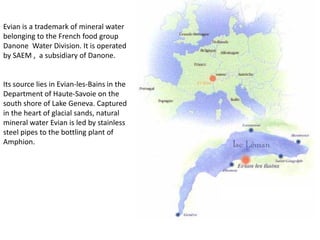Evian
- 1. Live Young
- 2. Evian is a trademark of mineral water belonging to the French food group Danone Water Division. It is operated by SAEM , a subsidiary of Danone. Its source lies in Evian-les-Bains in the Department of Haute-Savoie on the south shore of Lake Geneva. Captured in the heart of glacial sands, natural mineral water Evian is led by stainless steel pipes to the bottling plant of Amphion.
- 3. Plastic packaging is manufactured locally from materials tested to preserve all the inner qualities of natural mineral water Evian. Glass PET bottles are 100% recyclable and like any conditioner, Evian pays its Green Point contribution to Eco-Packaging. Evian water is the most sold in France, United Kingdom, Belgium, Switzerland, but also the most imported water sold in the United States and second in Japan. Evian water is also transported by boat up to Canada. In 2008, the Evian Annual production amounted to 1.5 billion litres.
- 4. Evian first entered the U.S. market in 1978 where it was served in posh restaurants, lounges, and hotels in New York City and in Hollywood. In addition to mineral water, Danone Group uses the Evian name for a line of organic skin care products as well as a luxury resort in France and a worldwide known Golf Tournament. In popular culture, Evian is portrayed as a top of the market and pricey bottled water, making it popular among Hollywood celebrities. David LaChapelle photographed an Evian marketing campaign juxtaposing a supermodel next to an Evian fountain to look like a Greek statue. In addition, high fashion designer Jean Paul Gautier has produced a Limited number of fashion bottles.
- 5. The tests: Evian make more than 300 microbiological tests a day on its water. The controls serve to make sure that no pollution appears in the assembly line. The transport Every day, from 6 to 8 trains leave the factory to deliver bottles in all foreign countries through many ports. A train can transport up to 570 000 bottles of 1,5litre each. The water of Evian is distributed in 100 countries in the world.
- 6. History •1789: During a walk, the Marquis of Lessert drank water from the Sainte Catherine’s spring on the land of a Mr Cachat. The marquis, who was allegedly suffering from kidney and liver problems, regularly drank the water while he was walking, and claimed that his health had improved. Encouraged by Lessert's testimony of the 'miraculous' water, local doctors began to prescribe it as a health remedy. In response to the growing success of the water, Mr Cachat fenced off his spring and began selling the water. •1824: The first baths appeared. The name of the spring was changed from Sainte Catherine to the Cachat Source. •1826: The Duke of Savoy gave his permission to start bottling water from the spring. •1829: The first Société des Eaux Minérales (Mineral Water company) was founded. •1859: The business became a public company as the "Société Anonyme des Eaux Minérales de Cachat".
- 7. •1860: The business became French when Savoy was incorporated into France under the Treaty of Turin. •1878: The French Ministry of Health reauthorized the bottling of Cachat water on the recommendation of the Medicine academy. •1908: Evian water began to be sold in glass bottles manufactured by the glass factory Souchon-Neuvessel which today is a part of Owens-Illinois. •1969: The first PVC bottle was launched. •1970: The BSN Group, which eventually became the Danone Group, took 100% control of Evian brand. •1995: Evian switched to collapsible PET bottles. •2001: Launch of the Evian organic cosmetics branch. •2009: Launches commercial: "Evian Roller Babies". Wins Gold Award at the London International Awards 2009 for Best Visual Effects.
- 8. Environmental record Bottled water sales in the UK went down by 9 percent in the first few months of 2008, after rising at more than 6 percent annually for 10 years. This could be due to the fact that there was an environmental backlash on bottled water that claims it was “immoral and wasteful”. In April 2008, Evian created the Evian Water Protection Institute to work on three water and wetlands management projects with the Ramsar Convention. The three areas where the projects will take place are: Thailand’s Bung Khong, the La Plata Basin in Argentina, and the Jagadishpur Reservoir in Nepal. Evian has also taken the initiative to cut down their own energy and water use by incorporating post-consumer recycled PET plastic into some bottles. The company has joined the RecycleBank in an effort to get consumers to recycle. Recyclebank is an award-based company that gives participating households redeemable points according to the amount of materials they recycle.







